Brandon Victor
Off to new Shores: A Dataset & Benchmark for (near-)coastal Flood Inundation Forecasting
Sep 27, 2024



Abstract:Floods are among the most common and devastating natural hazards, imposing immense costs on our society and economy due to their disastrous consequences. Recent progress in weather prediction and spaceborne flood mapping demonstrated the feasibility of anticipating extreme events and reliably detecting their catastrophic effects afterwards. However, these efforts are rarely linked to one another and there is a critical lack of datasets and benchmarks to enable the direct forecasting of flood extent. To resolve this issue, we curate a novel dataset enabling a timely prediction of flood extent. Furthermore, we provide a representative evaluation of state-of-the-art methods, structured into two benchmark tracks for forecasting flood inundation maps i) in general and ii) focused on coastal regions. Altogether, our dataset and benchmark provide a comprehensive platform for evaluating flood forecasts, enabling future solutions for this critical challenge. Data, code & models are shared at https://github.com/Multihuntr/GFF under a CC0 license.
Implicit Assimilation of Sparse In Situ Data for Dense & Global Storm Surge Forecasting
Apr 05, 2024



Abstract:Hurricanes and coastal floods are among the most disastrous natural hazards. Both are intimately related to storm surges, as their causes and effects, respectively. However, the short-term forecasting of storm surges has proven challenging, especially when targeting previously unseen locations or sites without tidal gauges. Furthermore, recent work improved short and medium-term weather forecasting but the handling of raw unassimilated data remains non-trivial. In this paper, we tackle both challenges and demonstrate that neural networks can implicitly assimilate sparse in situ tide gauge data with coarse ocean state reanalysis in order to forecast storm surges. We curate a global dataset to learn and validate the dense prediction of storm surges, building on preceding efforts. Other than prior work limited to known gauges, our approach extends to ungauged sites, paving the way for global storm surge forecasting.
A systematic review of the use of Deep Learning in Satellite Imagery for Agriculture
Oct 03, 2022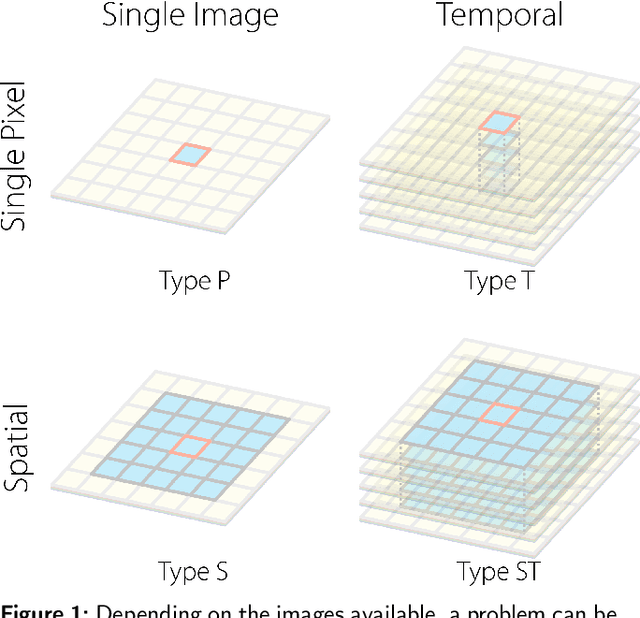

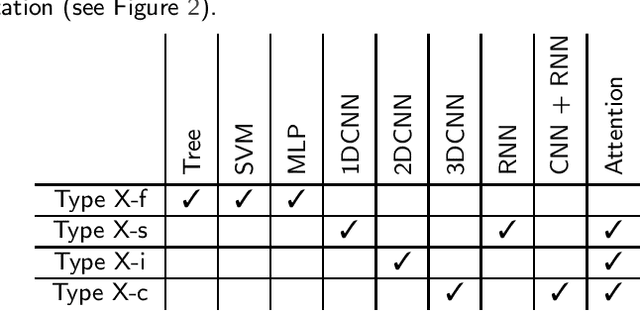
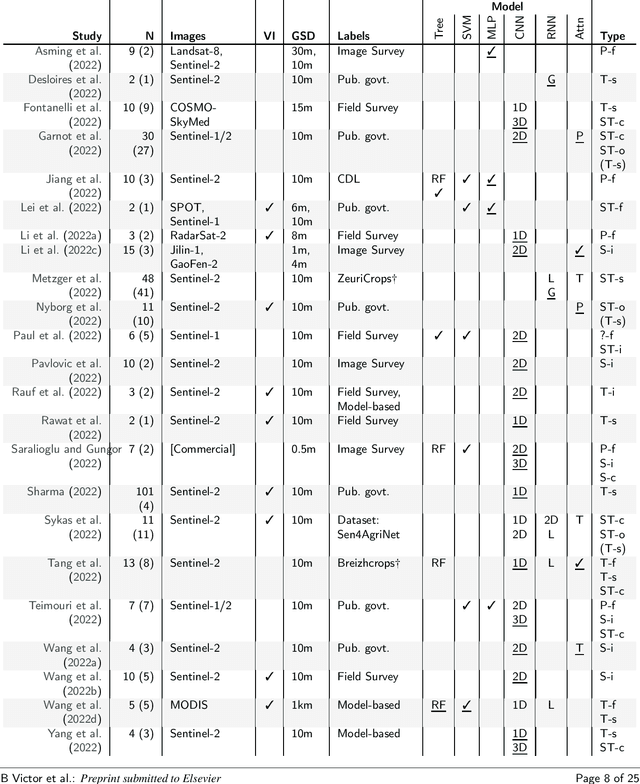
Abstract:Agricultural research is essential for increasing food production to meet the requirements of an increasing population in the coming decades. Recently, satellite technology has been improving rapidly and deep learning has seen much success in generic computer vision tasks and many application areas which presents an important opportunity to improve analysis of agricultural land. Here we present a systematic review of 150 studies to find the current uses of deep learning on satellite imagery for agricultural research. Although we identify 5 categories of agricultural monitoring tasks, the majority of the research interest is in crop segmentation and yield prediction. We found that, when used, modern deep learning methods consistently outperformed traditional machine learning across most tasks; the only exception was that Long Short-Term Memory (LSTM) Recurrent Neural Networks did not consistently outperform Random Forests (RF) for yield prediction. The reviewed studies have largely adopted methodologies from generic computer vision, except for one major omission: benchmark datasets are not utilised to evaluate models across studies, making it difficult to compare results. Additionally, some studies have specifically utilised the extra spectral resolution available in satellite imagery, but other divergent properties of satellite images - such as the hugely different scales of spatial patterns - are not being taken advantage of in the reviewed studies.
A comprehensive solution to retrieval-based chatbot construction
Jun 11, 2021



Abstract:In this paper we present the results of our experiments in training and deploying a self-supervised retrieval-based chatbot trained with contrastive learning for assisting customer support agents. In contrast to most existing research papers in this area where the focus is on solving just one component of a deployable chatbot, we present an end-to-end set of solutions to take the reader from an unlabelled chatlogs to a deployed chatbot. This set of solutions includes creating a self-supervised dataset and a weakly labelled dataset from chatlogs, as well as a systematic approach to selecting a fixed list of canned responses. We present a hierarchical-based RNN architecture for the response selection model, chosen for its ability to cache intermediate utterance embeddings, which helped to meet deployment inference speed requirements. We compare the performance of this architecture across 3 different learning objectives: self-supervised contrastive learning, binary classification, and multi-class classification. We find that using a self-supervised contrastive learning model outperforms training the binary and multi-class classification models on a weakly labelled dataset. Our results validate that the self-supervised contrastive learning approach can be effectively used for a real-world chatbot scenario.
Enhancing Trajectory Prediction using Sparse Outputs: Application to Team Sports
Jun 01, 2021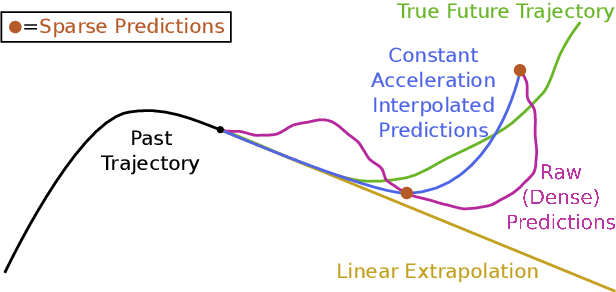

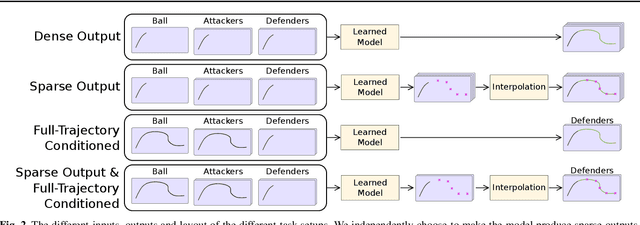
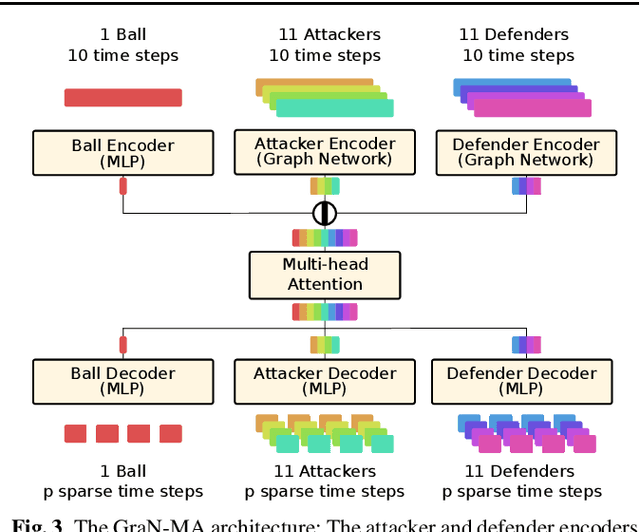
Abstract:Sophisticated trajectory prediction models that effectively mimic team dynamics have many potential uses for sports coaches, broadcasters and spectators. However, through experiments on soccer data we found that it can be surprisingly challenging to train a deep learning model for player trajectory prediction which outperforms linear extrapolation on average distance between predicted and true future trajectories. We propose and test a novel method for improving training by predicting a sparse trajectory and interpolating using constant acceleration, which improves performance for several models. This interpolation can also be used on models that aren't trained with sparse outputs, and we find that this consistently improves performance for all tested models. Additionally, we find that the accuracy of predicted trajectories for a subset of players can be improved by conditioning on the full trajectories of the other players, and that this is further improved when combined with sparse predictions. We also propose a novel architecture using graph networks and multi-head attention (GraN-MA) which achieves better performance than other tested state-of-the-art models on our dataset and is trivially adapted for both sparse trajectories and full-trajectory conditioned trajectory prediction.
Continuous Video to Simple Signals for Swimming Stroke Detection with Convolutional Neural Networks
May 28, 2017



Abstract:In many sports, it is useful to analyse video of an athlete in competition for training purposes. In swimming, stroke rate is a common metric used by coaches; requiring a laborious labelling of each individual stroke. We show that using a Convolutional Neural Network (CNN) we can automatically detect discrete events in continuous video (in this case, swimming strokes). We create a CNN that learns a mapping from a window of frames to a point on a smooth 1D target signal, with peaks denoting the location of a stroke, evaluated as a sliding window. To our knowledge this process of training and utilizing a CNN has not been investigated before; either in sports or fundamental computer vision research. Most research has been focused on action recognition and using it to classify many clips in continuous video for action localisation. In this paper we demonstrate our process works well on the task of detecting swimming strokes in the wild. However, without modifying the model architecture or training method, the process is also shown to work equally well on detecting tennis strokes, implying that this is a general process. The outputs of our system are surprisingly smooth signals that predict an arbitrary event at least as accurately as humans (manually evaluated from a sample of negative results). A number of different architectures are evaluated, pertaining to slightly different problem formulations and signal targets.
 Add to Chrome
Add to Chrome Add to Firefox
Add to Firefox Add to Edge
Add to Edge